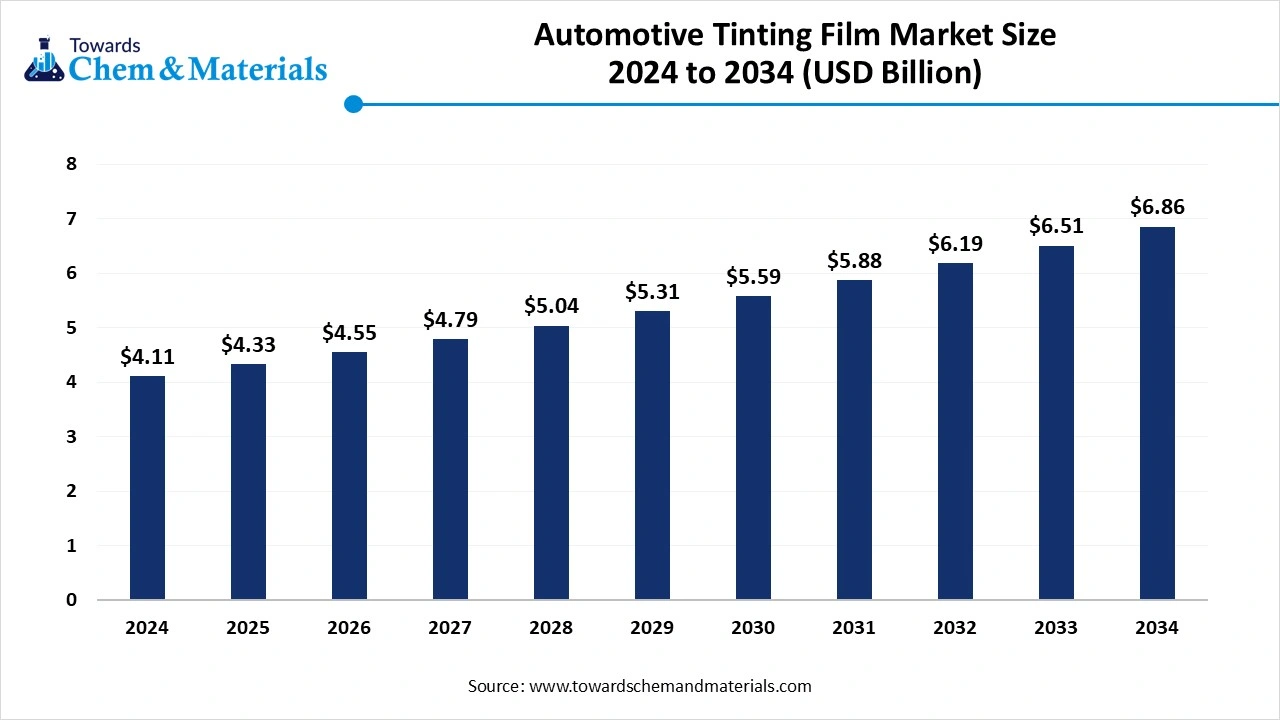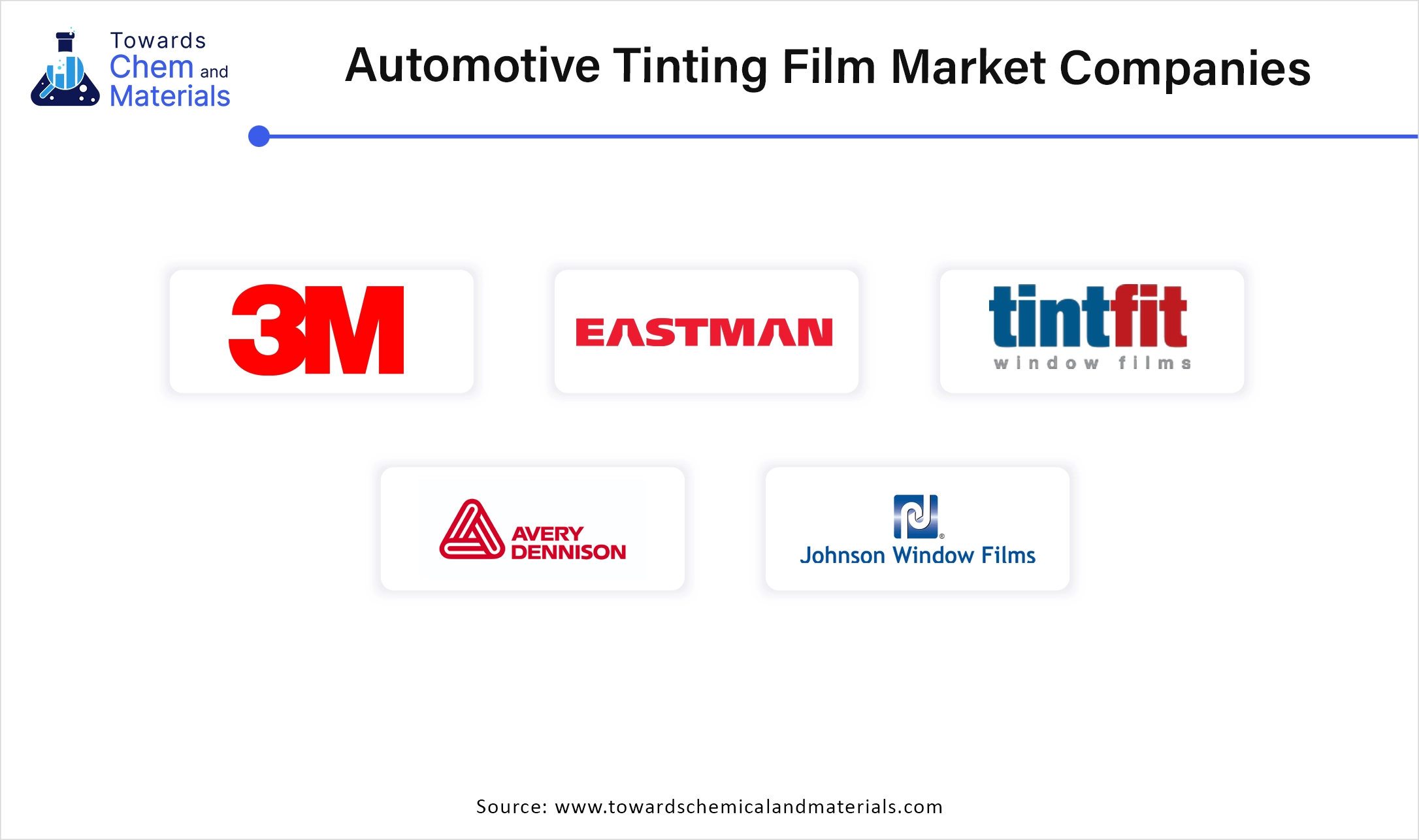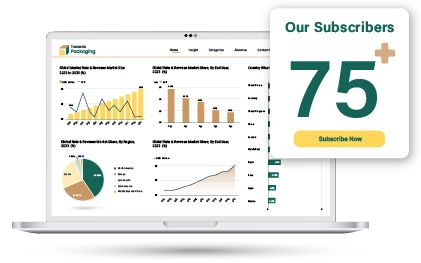Content
Automotive Tinting Film Market Size and Share 2034
The global automotive tinting film market size accounted for USD 4.11 billion in 2024 and is predicted to increase from USD 4.33 billion in 2025 to approximately USD 6.86 billion by 2034, expanding at a CAGR of 5.25% from 2025 to 2034. Rising vehicle sales, trend towards vehicle customization, and increasing consumer Rising vehicle sales, trend towards vehicle customization, and increasing consumer.

Automotive Tinting Film Key Takeaways
- By region, North America dominated the market in 2024 due to the growing automotive industry.
- By region, Asia Pacific is expected to dominate the market in the upcoming
By product, windshield segment dominated the automotive tinting film market in 2024, due to its heat rejection, UV protection, and glare reduction properties. - By product, windows application segment observed to grow at the fastest rate during the forecast period, attributed to increasing demand of improving privacy, enhancing safety and controlling solar energy.
- By application, passenger cars segment held the dominating share of automotive tinting film market in 2024, due to the growing popularity of these films to shield interior surfaces and improving visibility.
- By application, light commercial vehicles observed to grow at the fastest rate during the forecast period due to increasing demand to reduce solar heat gain and enhancing driver comfort and privacy.
Booming automotive industry demands automotive tinting film for UV protection, enhancing safety and privacy accelerate the market expansion.
Automotive tinting film are also knowing as window tint, typically made of polyester or other polymer materials with specialized coatings .there are various types of tinting film used in automotive including metalized, ceramic, and carbon films which each possess different characteristics. Booming automotive industry demands the use automotive tinting film in due to its ability of heat reduction, UV protection and glare reduction.
Automotive tinting film blocks solar energy which significantly lowers the interior temperature and protects the interior from the damage caused due to UV rays. It gives comfort to driver and passenger by glare reduction and increases privacy for passenger by using dark tint.
Due to increased need of aesthetic look for expensive cars demand automating tinting film which increase overall look and feel of the vehicle, propels the market. Additionally, the government regulation increases demand of automotive window films, the films that possess higher VLT rating and those approved by RT are contributing to drive the automotive tinting film market.
Automotive Tinting Film Trends
- Increasing Demand for Vehicles: Global vehicle production is growing rapidly due to urbanization, increasing disposable income and growing working population, needs the more cars which significantly increases demand of automotive tinting film. Rising shift towards UV protection, safety, aesthetic look and interior preservation from sunlight demands the automotive tinting film.
- Accelerating Electric vehicle adoption: Electric vehicle is very sensitive to energy consumption and tinting films are used to reduce heat gain inside the vehicle which further reduces the need of air conditioning. The global Shift towards the electric vehicle adoption driving the market.
- Technological progress in automotive tinting film: Various technological advancements specifically the nano ceramic film is showing market growth due to its ability of heat rejection and UV protection without compromising the visibility.
- This film gives more durability, and aesthetic look which increases the popularity in the market. Environment friendly tinting solution is also driving the automotive tinting film market.
- In March 2025, Tokyo, Toray Industries, launched the PICASUS™ VT, which is nano multilayer film. It is Applied to head-up display technology, these displays remain clear even when viewed through polarized sunglasses.
Automotive Tinting Film Market Scope
| Report Atributes | Details |
| Market Size in 2025 | USD 4.33 Billion |
| Expected Size in 2024 | USD 6.86 Billion |
| Growth Rate | CAGR of 5.25% from 2025-2034 |
| Base Year of Estimation | 2024 |
| Forecast Period | 2025-2034 |
| High Impact Region | North America |
| Segment Covered | By Product, By Application, By Region |
| Key Company Profiled | Saint-Gobain Performance Plastics Corporation,TWF,Armolan,3M,Eastman Chemical Company,TintFit Window Films Ltd.,Avery Dennison Israel Ltd. (Hanita Coatings RCA Ltd.),Johnson Window Films, Inc.,GLOBAL WINDOW FILMS,Madico, Inc.,NEXFIL,Solar Screen International SA,Huper Optik USA |
Automotive Tinting Film Opportunity
Progress in Tinting Film Technology
Advancement in film technology, particularly the nanotechnology which offers superior heat rejection and UV protection are showing significant market opportunities for automotive tinting film. Smart windows made by using electrochromic technology offer privacy and safety, potentially reducing the need of traditional tinting. The automatic and dynamic tinting which allows the glass to dark in the response to sunlight is driving the market. Tinting films which are made by eco-friendly material, possesses lower carbon footprint and broader sustainability, contributes to growth of automotive tinting film market.
Rising demand for customized film
Consumers are continuously looking for vehicle personalization to express their individuality. Automotive films offer wide range of colors pattern and finishes which give aesthetic look without permanent modification. It creates various opportunities for manufactures to develop premium and customized tinting solution to offer aesthetic look, heat rejection and improved visibility. Advanced window films with superior heat rejection, UV protection is gaining popularity.
Automotive Tinting Film Challenges
High Installation Cost of Premium Automotive Films
Premium automotive films require specialized equipment and knowledge for proper application leads to increase labor cost. Large vehicle requires more films resulting increases overall cost which limit the use of premium films. Although premium film gives the lots of benefit but these benefits may not be worth the premium to all consumers. Additionally, the presence of lower cost and lower quality tinting films dispirit the consumer to invest in high premium option which limits the automotive tinting film market growth.
Government Regulations on Automotive Film
To enhance road safety by ensuring clear visibility for driver the government set some regulation to use the tinted films to vehicles. Particularly in India according to CMVR rule 100 the minimum of 70% Visible light transmission needed for front and rear windshields and 50% VLT for side windows. This strict government regulation may limit the growth of the market.
Automotive Tinting Film Regional Insights
North America dominated market in 2024, expected to grow during forecast period. Strong vehicle ownership has developed road infrastructure and trend of vehicle customization increases demand of automotive tinting film in this region. North America including the U.S. and Canada has a vast number of vehicles. Specifically, the U.S. alone has well-established road infrastructure and a greater number of vehicles contributing to market growth.
In North America growing trend towards customized vehicles and customers preferences for safety and privacy by UV protection and heat reduction demands the tinting film. In North America consumers are willing to spend more on tinting light commercial vehicle than passenger cars, further boosting the market. The U.S. automotive tinting film market is experiencing strong growth, due to factors like vehicle customization and the demand for functional benefits like UV protection and heat reduction
Asia Pacific is showing significant growth in automotive tinting film market in 2024. Booming automotive industry and high vehicle production and ownership increases market growth this region. In Asia pacific rising economic development and increased population demands large number of vehicles further demands automotive tinting film. Various technological advancements like ceramic and carbon films which provide UV protection without compromising visibility are driving factor in this region.
Particularly developed countries like India, China and Japan are showing significant market growth due to the increased number of vehicles and trend towards vehicle customization.
Increasing demand of used vehicle has contributed to market growth because owners look to enhance their vehicle appear. Government policies in some regions, specifically China has broad environmental policies and regulations to improving air quality, reducing emissions, and promoting energy efficiency in various sectors, increases demand of automotive tinting film in this region.
Automotive Tinting Film Segmental Insights
Type Insights
The windshield segment held the dominating share of the automotive tinting film market in 2024. Windshield plays very important role in driver safety and visibility, Tinting films can help reduce glare and protect against UV rays, enhancing the driving experience and safety.
Consumers are continuously looking for enhancement in comfort and protection further driving the demand for windshield tinting. Various technological advancements including scratch-resistant and UV-protected glass, are also playing a role in increasing the demand for windshield segment. Government regulations regarding car window tinting film are very strict to ensure road safety by maintaining clear visibility, they often allow for darker tints on windshields, particularly for certain vehicle types or regions.
The windows segment is expected to grow at the fastest rate in the market during the forecast period. Increased demand for safety, comfort and aesthetic look in window application, drives the market. Due to expansion of passenger vehicle segment consumers are seeking window film solution for their vehicle due to increased expansion, contributing to overall market growth. Luxury and premium vehicle demand window tinting film to improve the aesthetic look, which may contribute to market growth in future.
Application Insights
The passenger cars segment held the dominating share of the automotive tinting film market in 2024. Rising disposable income, urbanization, increased population and growing demand of personal transportation, contribute to market growth of passenger vehicle.
Vehicle owners are looking to enhance the appearance and functionality of cars which leads to increase preference of tinting films. Tinting films effectively blocks UV ray and protects the passengers and interior from sun damage increases demand of tinting film. Increasing awareness of the benefits of film and growing desire for both functional and aesthetic enhancements in personal vehicles drive the market.
The light commercial vehicles segment is expected to grow at the fastest rate in the automotive tinting film market during the forecast period. Light commercial vehicle including vans and trucks require protection from sunlight which demands tinting films to reduce heat and air conditioning.
Light commercial vehicle driver spending more time behind the wheel which increases heat and UV exposure so tinting film is used to solve this issue. The increasing application of tinted films in buses, trucks, and light commercial vehicles was driven by benefits such as heat rejection, glare reduction, and improved privacy. Fleet operators adopted films to improve fuel efficiency, driver comfort, and branding through vehicle wraps, expected to support sustained growth in the commercial segment over the coming years.
Automotive Tinting Film Recent Developments
Hyundai Motor
- Product Launch: In April 2024, Hyundai Motor Company launched the world’s first application of Nano Cooling Film. It is a vehicle window tint which offers a significant improvement in interior cooling performance compared to conventional tint films. This innovative transparent film is expected to be more effective in hot and dry climates, as the cooling effect is optimized at higher outdoor temperatures.
Ceramic Pro
- Product Launch: In 2024, Ceramic Pro launched a new line of paint protection films, including a Windshield Protection Film. Which is known as Ceramic Pro Paint Protection Film, It contain both gloss and matte finishes, and even color-change films. The Windshield Protection Film is designed to shield windshields from damage like chips, cracks, and road debris
Avid
- Product Launch: In June 2024, Avid introduced XPEL's PRIME automotive window tint. XPEL is known for its high-performance, heat-rejecting, and UV-protecting window films. The PRIME series offers a range including PRIME CS BLACK, PRIME XR BLACK, and PRIME XR PLUS.
Automotive Tinting Film Top Companies List

- Saint-Gobain Performance Plastics Corporation
- TWF
- Armolan
- 3M
- Eastman Chemical Company
- TintFit Window Films Ltd.
- Avery Dennison Israel Ltd. (Hanita Coatings RCA Ltd.)
- Johnson Window Films, Inc.
- GLOBAL WINDOW FILMS
- Madico, Inc.
- NEXFIL
- Solar Screen International SA
- Huper Optik USA
Automotive Tinting Film Segments Covered
By Product
- Windows
- Windshields
By Application
- Passenger Cars
- Light Commercial Vehicles (LCVs)
- Heavy Commercial Vehicles (HCVs
By Regional
- North America
- U.S.
- Canada
- Europe
- Germany
- UK
- France
- Italy
- Spain
- Sweden
- Denmark
- Norway
- Asia Pacific
- China
- Japan
- India
- South Korea
- Thailand
- Latin America
- Brazil
- Mexico
- Argentina
- Middle East and Africa (MEA)
- South Africa
- UAE
- Saudi Arabia
- Kuwait
- Report Covered: [Revenue + Volume]
- Historical Year: 2021-2023
- Base Year: 2024
- Estimated Years: 2025-2034

